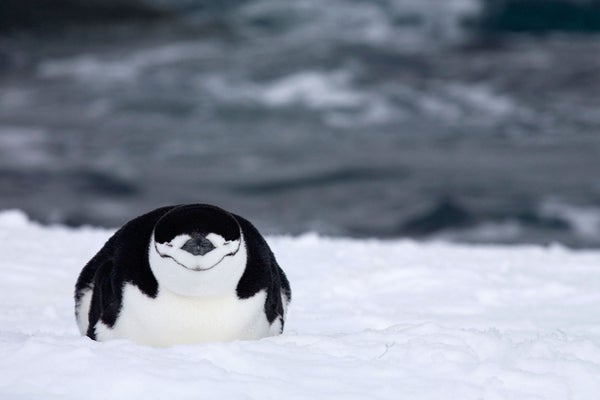For soon-to-be Chinstrap Penguin parents, getting enough sleep is tough. Not only do the seabirds nest in crowded, noisy colonies, but they are also often on full-time egg duty when their partners head out to sea to forage for days. To keep their developing chicks safe from predators, the penguin parent who is left behind must remain vigilant around the clock.
Now scientists have figured out how they accomplish such a feat without becoming sleep-deprived: the feathery mamas and papas take more than 10,000 micronaps a day. The findings, published today in Science, reveal that these seconds-long naps add up to more than 11 hours of sleep per day, helping the seabirds snooze as they safeguard their nests.
According to co-lead author Paul-Antoine Libourel, a researcher at the Lyon Neuroscience Research Center in France who studies sleep across the animal world, the findings highlight how little we know about sleep in nonmammals, especially birds.
On supporting science journalism
If you're enjoying this article, consider supporting our award-winning journalism by subscribing. By purchasing a subscription you are helping to ensure the future of impactful stories about the discoveries and ideas shaping our world today.
Named after their thin “chinstrap” of black feathers, Chinstrap Penguins (Pygoscelis antarcticus) nest on rocky slopes along the Antarctic Peninsula and nearby islands. While the two-foot-tall adult penguins are safe from terrestrial predators, their eggs and hatchlings are tasty snacks for Brown Skuas (Stercorarius antarcticus), large gull-like predators with voracious appetites. Fellow Chinstrap Penguins can also destroy or dislodge one another’s eggs as the new parents jostle for space on the overcrowded nesting ground.
To determine how the penguins keep their nests safe with seemingly little shut-eye, Libourel and his colleagues headed to a large chinstrap breeding colony on King George Island just north of the Antarctic Peninsula.
When penguin parents were swapping nesting and foraging duties, as they do throughout the roughly 37-day egg-incubation phase, the researchers captured one member of the pair and equipped it with sensors to measure the electrical activity of its brain. Tracking this activity indicates when a penguin’s brain is in sleep mode. Before returning the penguin to its nest, the team also attached sensors to the bird’s neck muscles to track head movements and a GPS monitor to its back to track activity at sea. They also stationed video cameras at several nests to directly observe the penguins’ behavior.
In total, they kept tabs on 14 Chinstrap Penguins as they incubated eggs around the colony. From the videos, they observed rapid-eye movements and drooping heads when the penguins were standing or lying down.
These sleepy behaviors were backed up by the penguins’ brain signals. The researchers pinpointed sleeplike activity in both hemispheres of the penguin’s brain throughout the day. These bouts of sleep averaged only four seconds each. But the penguins performed these “microsleeps” more than 10,000 times per day.
According to Libourel, many other species have drowsy states straddling wakefulness and sleep. In humans the behavior is often called nodding off. But very few species, if any, utilize this sleep strategy full time. “While other animals do have some drowsy state, we were not expecting that the penguins could sustain such extreme sleep fragmentation continuously,” Libourel says.
The brevity of Chinstrap Penguins’ bouts of sleep is unprecedented, according to Jennifer Arnold, a biologist who studies the evolutionary ecology of seabirds at Pennsylvania State University and was not involved in the new study. “The findings extend what we know about avian sleep as the sheer extent to which these birds are using microsleep is remarkable,” she says. In her own research, her team has observed terns utilizing short spells of eye closure, which may serve a similar function to the microsleep behavior of the penguins. She thinks these brief naps make perfect “evolutionary sense” because vigilance is vital for colonial nesting seabirds.
Chinstrap Penguins’ piecemeal sleep schedule also challenges the long-held belief that fragmented rest negatively impacts sleep quality. Instead even the briefest snoozes may incrementally add up to high-quality slumber for Chinstrap Penguins, allowing them to essentially sleep on the job. “We all know that if we sleep one hour versus two or three or four, there is a cumulative effect of more sleep,” Libourel says. “And we suspect here that this is the same for the penguins.”
